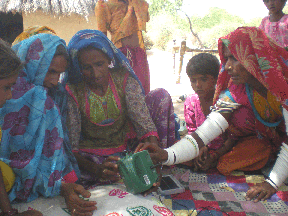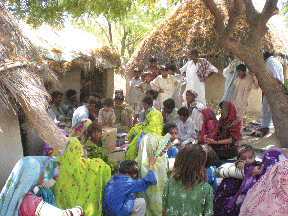How do villagers adapt and purchase small-scale solar technologies? hat vital components should a development programme address to make rural electrification successful? How can modern technology TV, lights, fans – be coupled with Millennium Development Goals (MDG)?
Location
The village Oan is located 19 km northwest of Nagar Parkar in District Tharparkar Sindh. Unlike most villages in Thar villages where 80 percent of people are is below the national poverty line, Oan is a ‘model village’ since the past decade due to access to water and improved

agriculture practices. However, as in the rest of Thar, there is a lack of electricity, water supply and gas services in this village. School and healthcare clinics are also far-spread, and there is no reliable public transport system.
Pilot Programme Details
A small pilot programme was conducted, where small-scale solar lights were introduced in Oan. It was difficult for the programme officers to determine the affordability or price point in the villages, as often the residents would not disclose their financial/monthly income even to NGOs who had been working with them for years. After negotiations by the community members to lower the set contribution, each village household (who agreed to purchase the product) contributed 40 percent of the total cost.
The product is a portable small solar light with a mobile charging component, which made the product extremely popular amongst the masses. It is noteworthy that with minimal advertising or marketing effort, the residents became interested in purchasing the solar light after one light was left at a local’s house as a sample for a few days.
The test programme demonstrated villagers’ willingness to learn and invest in solar technology. To make the programme financially sustainable:

- Lower-priced solar products have to be acquired;
- Micro-loan or credit will be helpful in recovering the amount. However, it is difficult for NGOs or small-scale enterprises to manage default and overdue payments for a small amount (under Rs. 5,000);
- Cluster of homes will be created together to decrease the total cost and provide responsibility for payments for larger photovoltaic systems.
Sustainability
The funds contributed by thevillagers will be recycled in an account until the next electrification programme is underway.
Corporate Partnerships
This project was supported in part by Deutsche Bank with a special focus on sustainability. Future collaborations are on the map with Telenor Pakistan, which recently started its services in Tharparkar district. Recipients in Oan will be (organically) providing mobile charging services for neighbours with mobile phones but without charging facilities. Dawood Capital Management Pvt. has volunteered to protect and manage the funds until the next rural electrification programme starts.
The use of solar energy offers huge potential for natural resource and climate protection, and for the expansion of renewable energies on the road to a future oriented energy supply.
Margareta Wolf
June 20, 2004






Thank you SaqIb. Indeed, Dlight Design was our product manufacturer in this project.
MESEC is welknown orginasation in Karachi Pakistan working for rural electrification projects by solar wind hybrid system in costal line and KT bundar areas.
We offer our service for all NGOs in this sector and R.O.plant for conversion of sea water into sweet water. We appreciate your for in the tharparkar areas.
These guys were looking for a partnership/distributor in Pakistan back in Nov 09. May be worth exploring if similar initiatives are still underway:
http://www.dlightdesign.com/products_nova_series_global.php
Hi Ambreen
Nice to see ur reports.
AWARE has updated its website http://www.aware.org.pk
plz have a look on that and share ur views, here r also some windmill and solar projects r being implemented by AWARE.
We wish for ur best endeavours.